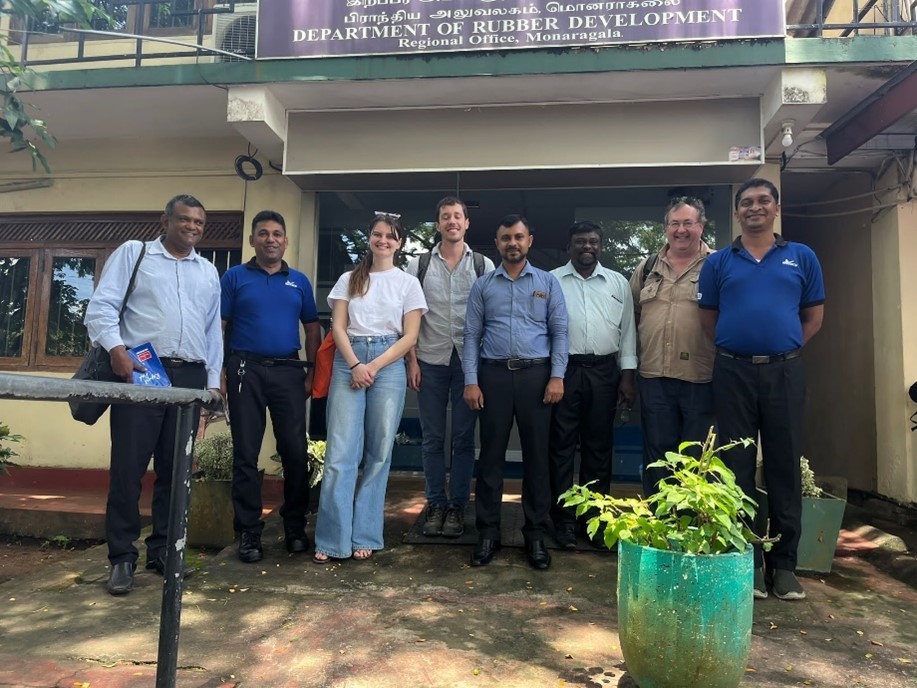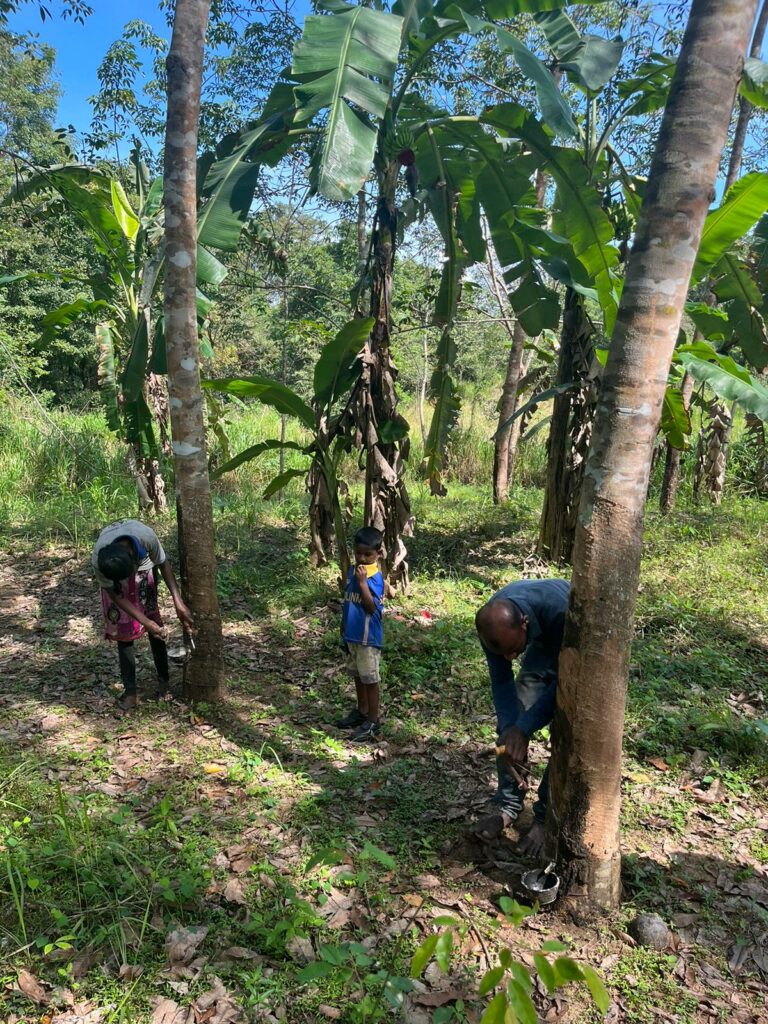The aim of the RIVER project (Rubber Improvement of Value chain & Embedded Smallholders Resilience) is to provide 6,000 Sri Lankan rubber farmers with agricultural training, access to the SUTTI digital solution and a secure, profitable market. In February 2023, Ksapa was in Colombo, the capital of Sri Lanka, to organize the launch of an initiative based around a multi-stakeholder coalition made up of public and private organizations with diverse and complementary expertise in areas such as agronomy, application development and impact measurement. The diagnosis is the first exercise in the RIVER project. It is defined as multi-sectoral, consisting of various studies on different themes, in order to gain a better understanding of the issues and opportunities in the context of the Sri Lankan rubber market.
The diagnostic phase of the RIVER project, a multi-sectoral approach to better understand the context and needs of beneficiaries
Even before starting the work with the farmers, Ksapa set-up and relied on a multi-stakeholder coalition to carry out a socio-economic analysis. Various organizations with complementary expertise were deployed in the target areas in order to gain a better understanding of the challenges on the ground. The objective is to understand the constraints and needs of small-scale rubber producers in a holistic way, in order to propose appropriate training and effective agronomic models based on current practices and in order to enhance income diversification and good farming practices.
In order to meet these objectives, it was important to understand farmers’ local economic fabric, as well as the challenges and risks of the rubber industry of Sri Lanka. This is why Ksapa divided up the roles of each of the partners and connected them in order to take account of their recommendations while ensuring a comprehensive synthesis understandable by every partner.
On the basis of this co-design process, the following studies were carried out during the diagnosis:
A global socio-economic analysis carried out by the Lanka Organic Agriculture Movement: LOAM is a non-governmental organization. Since 1994, LOAM has been promoting organic agriculture in Sri Lanka in collaboration with farmers, and universities in conjunction with private players facilitating the commercialization of products. Their experience in the field and their proximity to farmers are a real advantage in carrying out the diagnosis. In addition, LOAM was able to approach almost 300 rubber planters in the east of the country in the districts of Moneragala and Ampara, which are non-traditional natural rubber cultivation areas. The aim of this study is to establish a typology of farmers based on their resources (land, capital and labour) and socio-economic issues, in order to propose solutions (training, support, equipment, tools) adapted to the needs of each farmer profile. This exercise will also enable them to identify the knowledge and equipment they need to move their production system towards sustainable, economically efficient practices. To provide additional methodological input, Ksapa involved two agronomy students from Wellassa University in Badulla. The Sri Lankan students were able to help animate the workshops with the LOAM farmers, as well as expanding their knowledge of the field and techniques.
A technical diagnosis of agricultural practices in rubber plantations: Michelin, the main exporter of rubber in Sri Lanka and worldwide, invests in the improvement of agricultural practices by regularly offering training courses as well as visits to small farmers’ plots. As part of the RIVER project, a Michelin expert carried out a mission to identify the priority content to be provided to farmers via technical training, as well as the right methodological approach to ensure maximum adoption by farmers. To do this, a sample of 42 small farms was interviewed. The report includes a detailed description of the state of the rubber plantations in the target area, as well as recommendations for improving farming practices.
CIRAD observation of the diversity of rubber plantation in intercropping systems: CIRAD is a French tropical agronomy research institute. Two senior researchers were assigned to assist with the diagnosis of the RIVER project. Their field of expertise covers rubber agro-ecological practices and the economic analysis of agroforestry systems. During a ten-day field trip, they were able to visit the different zones to observe the diversity of crop associations and to identify the soil, climate and agronomic constraints faced by local farmers. They were able to compare their findings with other situations around the world. This helped to structure LOAM’s study questionnaires and to supervise the internship work of a French student studying agronomy and international development at ISTOM.
Technical and economic study of diversification strategies for intercropping rubber cultivation systems by an ISTOM student: As part of her final year internship, a student at the ISTOM School of Tropical Agronomy carried out a study of diversification strategies used by rubber producers in Sri Lanka. For four months, Laura was able to study the project areas and meet farmers who had set up innovative intercropping systems. Her aim was to identify one or more diversified and economically efficient cropping systems in order to propose an agronomic model that could be adopted by all the beneficiaries of the RIVER project. This study complements the initial field observations made by CIRAD researchers.
Technical support from Mazars to validate the impact measurement methodology: Mazars is an international leader in audit, tax and advisory services. As a member of the “FASEP Partners Club” and a structural partner of the SUTTI approach. Mazars’ contribution will enable the SUTTI impact measurement methodology to be framed and tested upstream on a concrete case, with the aim of replicating it for future deployments of the solution.
Legal support from DS Avocats to oversee the process and implementation of the project: As a French law firm, DS Avocats was one of the first law firms to set up operations in legal centers that were still ’emerging’ in the past, but are now at the heart of the global economy. With the support of legal professionals (solicitors and barristers) with dual expertise in both consultancy and litigation, DS Avocats is working with Ksapa through the FASEP business club to deal with the local legal issues involved in setting up and ensuring compliance with the SUTTI program.

What are the risks of a multi-stakeholder methodological approach?
The advantages
In a development project, a multi-stakeholder approach is essential. To set up and deploy a project in a developing country with risky economic situation, Ksapa had to take into account all the ins and outs of the sociological, economic and environmental context.
The RIVER project aims to have a long-term impact on the entire Sri Lankan rubber industry. It therefore appeared necessary to call on the various links in the value chain to identify the risks and issues involved. These links often find it difficult to communicate with each other and are undergoing profound changes at their own level.
The multi-stakeholder approach proved conclusive for a series of reasons:
Diversifying methodological approaches: different areas of expertise were applied to a single objective. The different points of view and methodologies enable solutions to be assessed from a variety of perspectives and an exhaustive analysis of the challenges.
Social immersion: working with local partners provides a key to understanding historical and social factors and their influence on farmers’ decision-making and local markets.
Strengthening relationships: the complementary nature of the organizations and the diversified methodological approaches encourage enriching exchanges. Each stakeholder feels free to put forward an innovative external point of view. The contribution of the partners is relative to their type of recommendation and their field of expertise, which contributes to the co-creation process. Workshops and discussion/debate sessions are also organized in collaboration with each of the stakeholders. This has required Ksapa to make a major effort in terms of coordination and communication.
The disadvantages
Nevertheless, the multi-actor approach can involve a number of risks:
Coordination: Ksapa is a hybrid organization made up of professionals with different areas of expertise, who select the best-qualified organizations and people in each sector. It is Ksapa’s role to ensure that discussions and deployment in the field are carried out in a uniform manner. The perspectives and experiences of each of the organizations participating in or linked to the project are taken into account in the recommendations that will serve as a basis for defining the expected impacts and therefore the activities to be implemented. It is therefore necessary to put the right people in touch with each other, anticipate meetings, define everyone’s role and create a shared vision in the interests of the project’s success.
Repetition: Ksapa’s role was to define everyone’s roles before the diagnosis was launched. This is an important key to success for the rest of the project. Clearly defining the roles and objectives of each stakeholder avoids repetition and potential redundancy in the various recommendations.
Translation: Customs and different languages can hamper communication on the project. It is important to go back over each of the recommendations made to ensure they are properly understood or, once again, to avoid repetition.
Conclusion
The multi-stakeholder approach is an interesting method that is well suited to the context of international development projects. During the diagnostic phase of the RIVER project, this led to the implementation of joint activities and close collaboration between the various stakeholders in order to achieve a common objective.
Ksapa was able to define the roles of each stakeholder and coordinate each stage of the diagnosis. Each recommendation is analyzed and shared in order to adjust the training programs as closely as possible to the challenges and demands of the Sri Lankan rubber industry.
Thanks to this approach, the deployment phase of the project will be adapted to the specific needs of farmers and project beneficiaries, taking into account the different challenges and the corresponding contributions required from all the stakeholders who will be involved in the project.
However, on the basis of the results of the diagnosis and in-depth research, new challenges and opportunities are emerging that need to be taken into account when adapting the next phases of the project. Ksapa, with the support of local partners, will co-develop an appropriate strategy to achieve the project’s objectives.

LAURA GUILLONNET
Laura is specialized in tropical agronomy and works at Ksapa as a Junior Program Officer. She is working on a diagnostic for the RIVER project for a field mission in Sri Lanka. She is in contact with local partners and makes the link with the research institutes. Her objective is to study the farming conditions of 6,000 rubber smallholders profiles participating in the program and identify opportunities in order to improve their income. Laura is currently closing her curriculum as engineer at ISTOM, an international Agri-development school in France. She decided to refine her agronomic knowledge and apply it to development projects during her second DA DEV master's degree at ISTOM. Laura already had international experiences on a 5-month mission in Ivory Coast, where she was supporting two cocoa cooperatives transitioning to organic agriculture. Laura speaks French and English.


